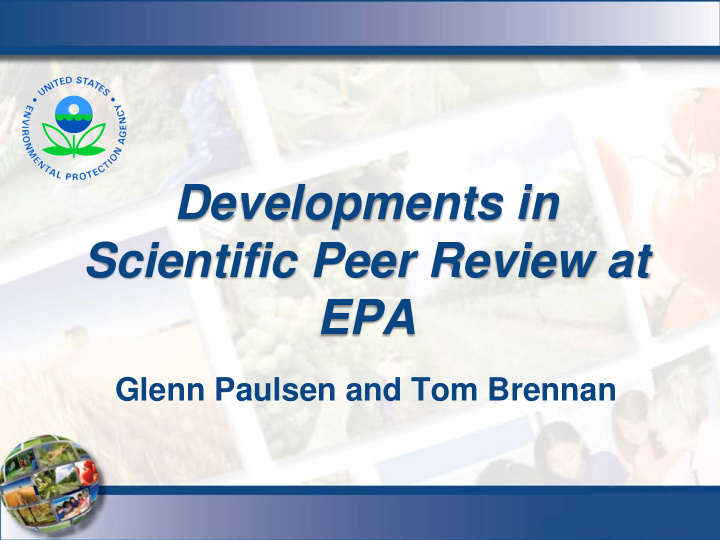



Developments in Scientific Peer Review at EPA Glenn Paulsen and Tom Brennan
Topics Areas Covered Today • History and practice of peer review at EPA; • New directions for the EPA; • Role of the EPA Science Advisory Board (SAB) in Peer Review at EPA; and, • SAB commitment to Transparency and Openness. 2
Scientific Peer Review at the EPA - history The agency has a long history of scientific peer review: • EPA first released a Peer Review Handbook in 1998. This was years before the OMB Bulletin on Peer Review laid out minimum standards for peer review at the federal agencies; • The EPA Peer Review Handbook is now heading into its 4 th Edition, expected to go final in 2014; • www.epa.gov/peereview 3
History continued • The EPA Deputy Administrator and Agency’s Science Advisor provide high-level leadership and oversight of peer review at the agency; • EPA achieves peer review of scientific and technical work products using a range of mechanisms, as appropriate for the complexity of the product and its intended use: – Publication in peer-reviewed scientific journals; – Letter review; – Panel reviews; and, – NAS reviews.
History - continued • EPA’s Peer Review Agenda, including completed and planned peer review activities, is available on the EPA website: http://cfpub.epa.gov/si/si_public_pr_agenda.cfm • Currently, there are 29 High Influential Scientific Assessments (HISA) and 50 Influential Scientific Information (ISI) products in the cue for Peer Review. • Typically, EPA does 20-30 HISAs and ISIs per year.
New Directions in Peer Review • In 2013, the EPA implemented a new process for peer reviews managed by contractors – to increase the transparency and rigor of reviewer selection - new: – Process includes public nomination and comment on expert candidates. – Additional consultations between the agency and the managing contractor regarding potential conflicts of interest of candidate experts. 6
New Directions - Continued Important themes in the new edition of the EPA Peer Review Handbook: • Strengthening the integrity of contractor- managed peer reviews; • Enhanced opportunities for public input to peer reviews; • Clarifying the role of EPA decision-makers in decisions on the type and timing of peer review of influential products. 7
Role of the SAB in Peer Review • EPA has a handful of scientific technical advisory committees that provide expert peer review advice. • The SAB has the broadest mandate to provide advice on scientific and environmental issues supporting EPA actions. • SAB is a statutory federal advisory committee, established in 1978. 8
Role of the SAB – Continued • The chartered SAB has approximately 50 members , including experts on a wide range of expertise; • The SAB reports directly to the Administrator; • Much of the peer review done by the SAB is conducted by specialized panels of experts formed to address an specific Agency charge; and, • All members serve as Special Governmental Employees, and are subject to ethics laws and regulations applicable to the Executive Branch. 9
Role of the SAB – Continued SAB operates under the requirements of the Federal Advisory Committee Act (FACA) as such: • The SAB charter is filed with Congress every two years. • SAB panels and committees are balanced in terms of scientific points of view for the work to be performed: 10
Role of the SAB – Continued SAB operates under the requirements of the Federal Advisory Committee Act (FACA) as such: • SAB panels deliberate in public; • Meetings are announced and open to the public; and, • All materials prepared by and for the SAB are available to the public. 11
Role of the SAB – Continued The SAB Staff Office provides technical and administrative support to the SAB: • Establishment of balanced panels of experts who have been carefully vetted for financial conflict of interest; • Liaison between the EPA and the SAB, and between the public and the SAB to guard against undue influence by the agency or outside interests on the deliberations of the SAB. 12
SAB Commitment to Transparency and Openness The SAB Staff Office goes beyond the legal requirements for and public input: • FR notices of opportunities to nominate experts to serve on the SAB and/or specialized panels and committees. • Opportunities to submit written comments and to provide oral comments at the meetings (both near the beginning and after deliberations). 13
SAB Commitment to Transparency and Openness – continued. The SAB Staff Office goes beyond the legal requirements for and public input: • As a matter of policy EPA and the SAB Staff Office apply FACA openness standards to all panel and committee meetings (not just the chartered SAB); • The SAB Staff Office posts all committee materials (including charge, public comments, agency briefings, draft advisory reports, and meeting minutes) to the SAB website. 14
SAB Commitment to Transparency and Openness – continued. The SAB Staff Office goes beyond the legal requirements for and public input: • New efforts to webcast SAB meetings, providing teleconference access, use of public dockets for materials and public comments. • www.epa.gov/sab 15
SAB Commitment to Transparency and Openness – continued. SAB reviews often focus on high-profile topics of interest to stakeholders, public, and Congress: • Hydraulic fracturing; • Economy-wide impacts of regulations; • Connectivity of wetlands and waters; • Environmental justice; • IRIS chemical toxicology assessments; and • More 16
Thank you for your Attention Brennan.thomas @epa.gov Questions? 17
Recommend
More recommend